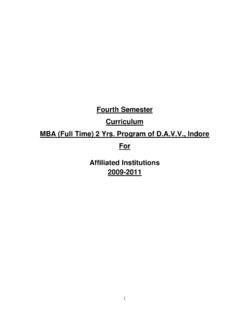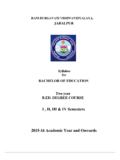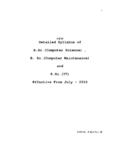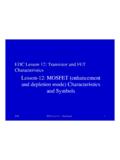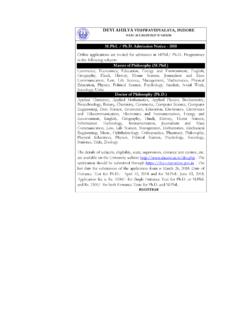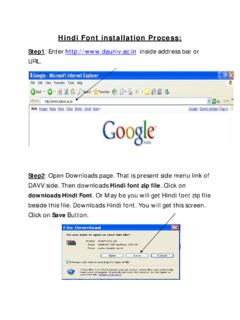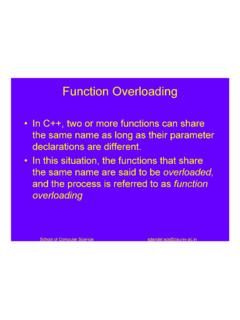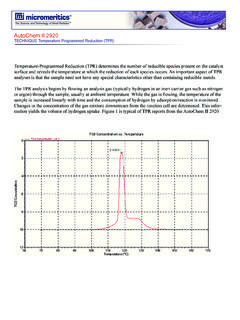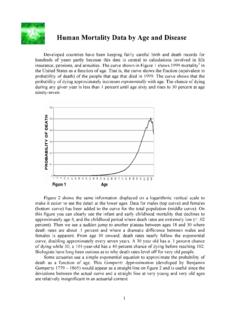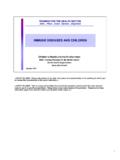Transcription of Programmed IO Chapter 11: Input/Output …
1 Chapter 11: Input/Output organisation Lesson 06: Programmed IO. Objective Understand the Programmed IO mode of data transfer Learn that the program waits for the ready status by repeatedly testing the status bit(s) and data transfer is only when other end ready Schaum's Outline of Theory and Problems of Computer Architecture 2. Copyright The McGraw-Hill Companies Inc. Indian Special Edition 2009. Three modes of transfer of device data, commands and status (i) Programmed IO. (ii) Interrupt driven IO. (iii) Direct memory access (DMA).
2 Schaum's Outline of Theory and Problems of Computer Architecture 3. Copyright The McGraw-Hill Companies Inc. Indian Special Edition 2009. Programmed IO mode input data transfer Schaum's Outline of Theory and Problems of Computer Architecture 4. Copyright The McGraw-Hill Companies Inc. Indian Special Edition 2009. Read input in Programmed IO mode (i) Each input is read after first testing whether the device is ready with the input (a state reflected by a bit in a status register) or whether the device input buffer is not empty Schaum's Outline of Theory and Problems of Computer Architecture 5.
3 Copyright The McGraw-Hill Companies Inc. Indian Special Edition 2009. input read by the processor in Programmed I/O mode Schaum's Outline of Theory and Problems of Computer Architecture 6. Copyright The McGraw-Hill Companies Inc. Indian Special Edition 2009. input read in Programmed IO mode The program waits for the ready status by repeatedly testing the status bit(s) and till all targeted bytes are read from the input device The program is in busy (non-waiting) state only after the device gets ready else in wait state Schaum's Outline of Theory and Problems of Computer Architecture 7.
4 Copyright The McGraw-Hill Companies Inc. Indian Special Edition 2009. Programmed IO mode output data transfer Schaum's Outline of Theory and Problems of Computer Architecture 8. Copyright The McGraw-Hill Companies Inc. Indian Special Edition 2009. output write in Programmed IO mode (ii) Each output written after first testing whether the device is ready to accept the byte(s) at its output register or output buffer is empty Schaum's Outline of Theory and Problems of Computer Architecture 9. Copyright The McGraw-Hill Companies Inc.
5 Indian Special Edition 2009. output write in Programmed IO mode Schaum's Outline of Theory and Problems of Computer Architecture 10. Copyright The McGraw-Hill Companies Inc. Indian Special Edition 2009. output write in Programmed IO mode The program waits for the ready status by repeatedly testing the status bit(s) and till all the targeted bytes are written to the device The program in busy (non-waiting) state only after the device gets ready else wait state Schaum's Outline of Theory and Problems of Computer Architecture 11.
6 Copyright The McGraw-Hill Companies Inc. Indian Special Edition 2009. Advantage and Disadvantage Programmed IO mode data transfer Schaum's Outline of Theory and Problems of Computer Architecture 12. Copyright The McGraw-Hill Companies Inc. Indian Special Edition 2009. Advantage of Programmed I/O mode A program and processor dedicated to wait and repeatedly tests the status and for IO data transfer till the IO operation completes Schaum's Outline of Theory and Problems of Computer Architecture 13. Copyright The McGraw-Hill Companies Inc.
7 Indian Special Edition 2009. Disadvantage of Programmed I/O mode A program has to wait and repeatedly tests the status; Waiting period for an asynchronous event can be too large Many I/O devices generate asynchronous events events that occur at times that the processor cannot predict or control, but which the processor must respond to reasonably quickly to provide acceptable performance Schaum's Outline of Theory and Problems of Computer Architecture 14. Copyright The McGraw-Hill Companies Inc. Indian Special Edition 2009.
8 Example of Unpredictable wait events Keyboard on a workstation or PC. The processor cannot predict when the user will press a key but must react to the key-press in well under a second or the response time will be noticeable to the user The Programmed I/O mode therefore not appropriate due to prolonged wait states Schaum's Outline of Theory and Problems of Computer Architecture 15. Copyright The McGraw-Hill Companies Inc. Indian Special Edition 2009. Summary Schaum's Outline of Theory and Problems of Computer Architecture 16.
9 Copyright The McGraw-Hill Companies Inc. Indian Special Edition 2009. We Learnt Programmed IO method of IO operations The program waits for the ready status by repeatedly testing the status bit(s) and data transfer is only when other end ready Schaum's Outline of Theory and Problems of Computer Architecture 17. Copyright The McGraw-Hill Companies Inc. Indian Special Edition 2009. End of Lesson 06 on Programmed IO. Schaum's Outline of Theory and Problems of Computer Architecture 18. Copyright The McGraw-Hill Companies Inc.
10 Indian Special Edition 2009.
